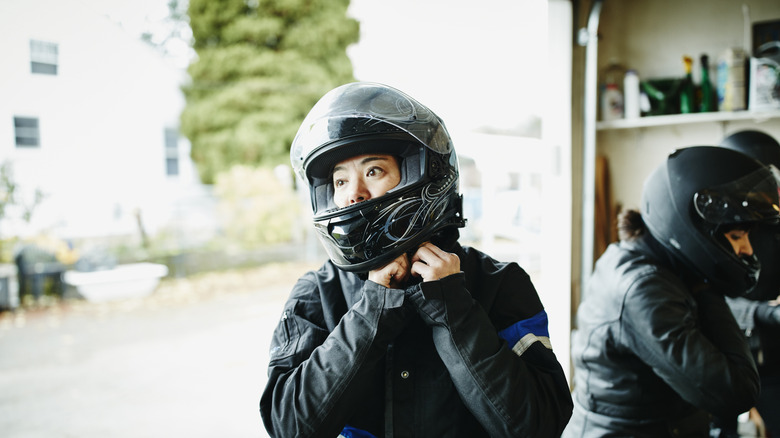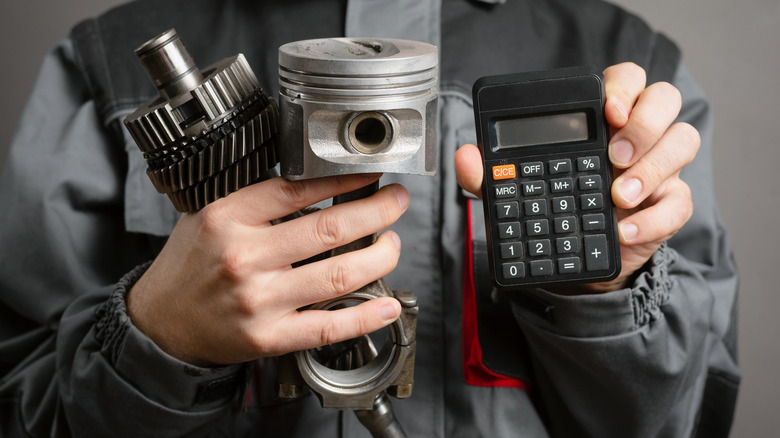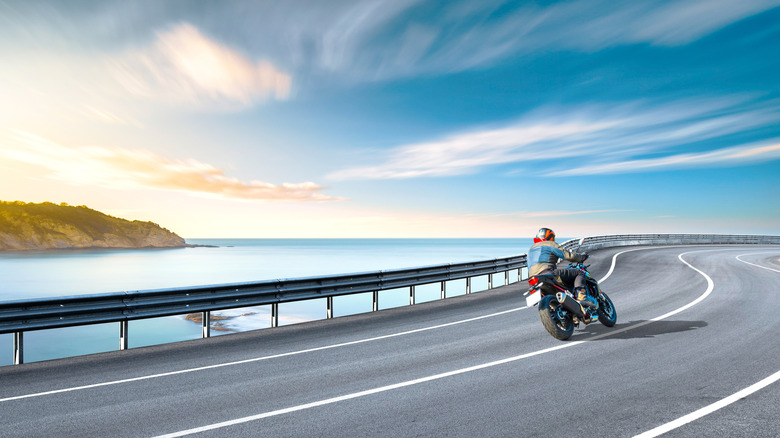So you’ve decided to buy a motorcycle. Congratulations! Motorcycling is the beloved hobby of many riders, and for good reason. The open road, the sensation of speed, and the wind in your hair all add up to an experience that can be thrilling, zen, and terrifying all at once.
Advertisement
However, buying your first motorcycle can be daunting. It’s a Catch-22: You need the experience to know what you want in a motorcycle, but you need a motorcycle to gain that experience. Don’t worry, we’ve got you covered. With decades of riding under our collective belts, SlashGear has the expertise and knowledge about what to consider when searching for your first love.
Read on as we examine everything you need to know about buying your first motorcycle, including getting licensed, finding the right gear, determining your preferred riding style, and combing through the myriad engine and riding options on the market today.
Safety first, last, and always
It goes without saying, but we’ll say it anyway: motorcycling is a dangerous hobby. Unlike cars, there is no steel cage, no airbags, and no seatbelts. A motorcycle’s slim profile doesn’t catch attention the way a full-sized vehicle does, making it especially dangerous in this era of distracted driving. Even minor accidents can have devastating consequences.
Advertisement
Before you venture into the world of motorcycles, the first stop you should make is a motorcycle safety course. The Motorcycle Safety Foundation (MSF), a national not-for-profit organization, offers a unique environment for both novice and advanced riders to practice new skills in a safe setting.
Each state has varying policies regarding motorcycle licensing. You can find details regarding your locality on the MSF website. The course usually provides a good beginner motorcycle along with classroom and practical instruction on the basics. Maybe you’ve grown up on dirt bikes or ATVs or are a previous rider returning to the saddle; the MSF course can still teach or refresh the skills you need to stay safe. It even offers options for advanced riders to continue their education.
Advertisement
While it’s possible in some areas to get licensed by riding with someone with a valid motorcycle license and passing a road test, this approach has risks. Even experienced riders can develop bad habits, which they might inadvertently pass on to you. For the safest learning experience, look to the professionals.
Determine what kind of riding you want to do
Before buying your first motorcycle, ask yourself what kind of riding you actually want to do.
There are two broad styles of motorcycle riding: on-road and off-road. Off-road bikes have suspensions with lots of play, resulting in taller motorcycles with knobby tires that help dig into the dirt. These may include street-legal dirtbikes, dual-sports, and adventure bikes.
Advertisement
On-road bikes tend to have smoother tires, lower clearance requirements, and a wider variety of engines. Street bikes range from ultra-comfortable cruisers with amenities on par with luxury cars to supersport bikes, which are essentially street-legal racing motorcycles.
Deciding which type of riding you wish to do will inform every other aspect of your motorcycle buying experience. It might be hard to decide, but envision yourself riding. Are you going for long Sunday rides once per week? Commuting to and from work daily? Do you anticipate taking your motorcycle to the local track or drag strip once you have enough experience?
It is important to find the Goldilocks bike that is just right for you to learn and grow into. Rest assured, most manufacturers have a range of bikes, from those suitable for beginners to those best reserved for advanced riders.
Advertisement
Types of motorcycles
Once you’ve determined what type of riding you wish to do, parsing out which bike best suits that style is next. These are the main motorcycle types every rider should know:
- Cruisers are heavier bikes with low saddles suitable for long rides. Picture the chrome Harley-Davidson in your neighbor’s garage or one of the Japanese imitations.
- Sportbikes are lightweight, usually high-revving, and have high power-to-weight ratios. They tend to sacrifice rider comfort for performance.
- Tourers prioritize rider and passenger comfort over other considerations, unlike sportbikes. Nonetheless, they can be very powerful and fast and tend to be heavy.
- Sport Tourers are sportbikes with nods to comfort like a more relaxed riding posture and optional luggage.
- Dual Sports combine off-road equipment like high ground clearances and advanced suspensions with on-road requirements like brake lights, headlights, and turn signals.
- Adventure bikes are sturdy, robust motorcycles equally comfortable on a rugged trail as a national highway. They can be rigged for everything from cross-continent adventure trips to daily commutes.
- Standard/Naked commuter bikes are suitable for on-road use and short-to-medium length joyrides.
- Scooters/Minis are small, light bikes with low displacement engines meant primarily for short-duration rides.
While some advise against new riders beginning on types like supersport bikes, they can learn to ride any of the above categories depending on their maturity level. Prospective buyers would do well to consider the motorcycle’s size, weight, and dimensions, and how it may work with their own body type.
Advertisement
Bike dimensions and body type
Unlike cars, motorcycles require whole-body physical input for optimal operation. They become an extension of your body while you ride. The lightest motorcycles on the market weigh as little as 225 pounds, while the heaviest can weigh over 1,000 pounds.
Advertisement
Finding an appropriate size and weight for your body type is paramount. A 5-foot, 1-inch rider who weighs 100 pounds will not be comfortable on a bike suited to someone who is 6 feet, 5 inches tall and weighs 300 pounds. The same goes in the opposite direction. A heavy rider on a light bike will negatively impact the performance. It’s not just about acceleration; overloaded bikes suffer in all aspects of riding, including cornering and braking.
Counterintuitively, it is low-speed maneuvering that challenges new riders. Bikes become more nimble and light-feeling at speed, but low speeds make them feel unwieldy and heavy. Ideally, a rider could plant both feet firmly on the ground at stop lights and maintain control over their machine in all situations.
Advertisement
Saddle height is a critically overlooked specification when it comes to motorcycle shopping. It represents the height of the motorcycle’s seat. Comparing it against your inseam will provide a helpful clue as to whether that bike is too tall (or too short) for you.
While someone of the most diminutive stature could drive a large truck, a good motorcycle fits its rider-like clothing. An ill-fitting, underpowered bike can be just as dangerous as one that’s too powerful.
Ergonomics
Motorcycle riding can be uncomfortable, and much of that is dictated by the riding style you want. For instance, cruisers offer a relaxed, feet-forward riding position, while adventure bikes provide a more upright stance. Supersport bikes require hunched riding positions. Luxury tourers like the Honda Gold Wing or Harley Davidson Road Glide are essentially very expensive couches with wheels.
Advertisement
Any part of the motorcycle you touch with your body can cause discomfort. Handle grips, footpegs, controls, and the seat are all common culprits. All have the potential for an aftermarket upgrade in case you find one wanting, but what’s not as easily adjustable is the all-important rider triangle.
The rider triangle accounts for the distance and angles between the three primary contact points of a motorcycle: saddle, grips, and pegs. It is a crucial aspect of motorcycle comfort. It’s important to understand that this space is occupied by your entire body. If you find yourself having to scrunch up or stretch out to engage with all three points, that may not be the right bike for you.
What feels comfortable for 10 minutes while chatting with the salesman may feel very different after hours of hard riding.
Advertisement
The poster boy for performance over comfort is the supersport Yamaha YZF-R1 (absolutely not a beginner bike). It employs a paper-thin plastic pad for a saddle and has a very cramped rider triangle. More beginner-friendly sports bikes like the Kawasaki Ninja 400 and 650 are also guilty of this.
Engine type and power delivery.
There is no hard and fast rule regarding what displacement is best for beginners. Engine type and how it delivers power are just as important.
Here is a brief rundown of the main engine types and their primary characteristics:
Advertisement
- Single cylinder engines are lightweight, small, and provide low-end torque over top speed power.
- Parallel twin engines use a pair of side-by-side cylinders. They are versatile and provide more mid-range power than a single.
- Flat-twin engines are a popular choice for adventure and cruising bikes. They feature a low center of gravity and a broad powerband.
- Inline-three or -four engines prioritize horsepower over torque and can range in power delivery from stable to touchy. They are often found in sports and standard motorcycles.
- V-configuration engines can have 2 to 8 cylinders. Most commonly arranged as twins, these motors produce torque across a wide power band.
Engine type can matter just as much as the displacement. The 600cc inline-four in the high-revving Yamaha R6 sportbike will act, feel, and deliver power entirely differently from the 600cc V-twin in the iconic Honda Shadow cruiser. While a good rule of thumb is to start on a small or middleweight displacement bike, the perfect beginner bike will come down to a combination of riding type, ergonomics, rider and motorcycle dimensions, and power delivery. The best beginner bike is one you can start on comfortably and grow into along with your skills.
Dress for the slide, not the ride
Let’s talk gear. You’ll never go awry by getting quality gear and wearing it every time you ride. Helmets are so crucial we’ll examine them in a separate section, but riding jackets, gloves, pants, and footwear are all motorcycle accessories that will make any ride safer — you should get it all.
Advertisement
On most motorcycles, riders manipulate the rear brake and the shifter with their feet. Long laces can get caught on equipment at bad times, and simple sneakers will shred to nothing in an accident. Sturdy, ankle-supporting boots made from leather or synthetic armored material are best.
Anything that survives prolonged, high-speed contact with the road will save you from the scourge of every rider: road rash. Many riders are satisfied with rugged denim jeans and leather jackets, but purpose-built riding clothing is best. Many manufacturers also make clothing with built-in Kevlar pads to protect from abrasions in an accident. The instinct to brace a fall with your hands means armored or leather gloves are also a must.
Advertisement
Every rider should get goggles or other purpose-built eyewear in lieu of a full-face helmet. Wind at high speeds causes eye irritation and can lead to dangerous situations. Non-motorcycle eyewear may not keep the wind at bay and could shatter on impact.
All clothing should be comfortable and fit correctly. Thinking about how cold you are or how tight your jacket is will only distract you from paying attention to the road.
Helmets
Let’s not sugarcoat it: The helmet is the most critical gear a rider can get. Some states may not mandate helmets, but they are absolutely necessary. The consequences of not wearing one can be severe. Every time you mount your bike, remember: no excuses, wear your helmet.
Advertisement
The most common helmet certifications include the U.S. Department of Transportation (DOT), the Economic Commission of Europe (ECE), Snell (voluntary testing undertaken by the Snell Memorial Foundation), and FIM (a requirement for certain racing bodies). A helmet with one or more of these certifications has undergone testing to specific safety standards. Uncertified helmets not only won’t provide the proper level of protection, but are illegal in many places where helmets are required.
The second consideration is fit. Not all heads are the same size. A too tight or loose helmet will not provide the same efficacy as a properly fitted one. The right helmet will feel a little tight while providing even pressure at contact points. Many manufacturers offer fitting guides for their products that compare sizes to the measurements of your head.
Advertisement
Helmets come in many styles, but full-face options are best. In addition to providing a built-in visor that eliminates the need for goggles, a full-face helmet protects parts of your face that half-shell helmets do not. Some riders prefer half-shell options, but ideally, no part of your body will be exposed during a ride.
Check out our guide to every major motorcycle helmet brand to get started.
Ancillary costs
Many automotive shoppers consider the price of the vehicle the most important consideration, and they’re not wrong. But remember that motorcycling comes with several other costs, some one-time and others repeating.
Advertisement
One example of a one-time cost is the purchase of gear. A high-quality, complete set of riding equipment, may cost a significant amount, but it’s an investment in your safety and comfort on the road. It’s the item you should least want to scrimp on.
Insurance costs will depend on the type of motorcycle, the rider’s age, and other factors. A 19-year-old on a supersport will see higher rates than a 45-year-old on a parallel twin standard. A liability-only policy averages $68 per month or $816 annually, while a full-coverage policy averages $148 monthly or $1,776 yearly. The overall average is about $108 per month or $1,296 annually. Not having insurance can leave you vulnerable to significant financial risk in the event of an accident, making it a crucial aspect of ownership.
Advertisement
Most of the time, if a car breaks down, you can pull safely to the side of the road. A malfunction on a motorcycle can have much harsher consequences. Keeping every facet of your bike in excellent operation is imperative.
The cost of motorcycle maintenance ranges from $800 to $1,500 annually, but it’s a small price to pay for peace of mind. Regular maintenance is not just a cost but a responsibility to yourself and others on the road.
The round-up
Learning to ride and buying a motorcycle may be the best thing you’ve ever done for yourself. There’s little doubt that the freedom and thrill of the open road taps into the souls of people everywhere, but the whole endeavor can be a little overwhelming. Someone could probably do a doctoral dissertation on what you should know before buying your first motorcycle, but it shakes down to a few basic tenets.
Advertisement
First, begin learning how to ride in a safe and controlled environment. You’ll never regret taking a class before purchasing a bike. No one ever suffered from additional experience.
Next, determine what type of riding you want to do. This will inform most of your needs surrounding engine type, motorcycle dimensions, and what kind of gear to get.
Third, narrow down the bikes that meet your requirements. Explore the lineups, research power numbers, haunt forums, and ask questions. Knowledge is power.
Lastly, go riding! Start slow, avoid traffic, practice in parking lots, and have fun! Just remember, always keep your head on a swivel. Motorcycling is an activity you must actively participate in at every moment to stave off disaster. But, done well and with a bit of luck, it could be a lifelong passion. Happy riding!
Advertisement












